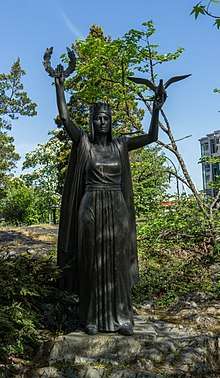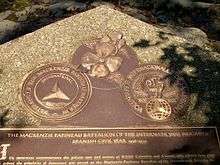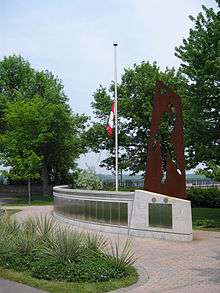Mackenzie–Papineau Battalion
| Mackenzie–Papineau Battalion | |
|---|---|
 Monument to the Mackenzie Papineau Battalion in Victoria, B.C. | |
| Active | 1937-1938 |
| Country |
|
| Allegiance |
|
| Type | Battalion - Infantry |
| Role | Home Defence |
| Part of |
|
| Engagements | |
| Commanders | |
| Notable commanders | Edward Cecil-Smith |
The Mackenzie–Papineau Battalion or Mac-Paps were a battalion of Canadians who fought as part of the XV International Brigade on the Republican side in the Spanish Civil War. Except for France, no other country gave a greater proportion of its population as volunteers in Spain than Canada.[1] The first Canadians in the conflict were dispatched mainly with the U.S. Abraham Lincoln Battalion and later the North American George Washington Battalion, with about forty Canadians serving in each group. The XV International Brigade was involved in the Battle of Jarama in which nine Canadians are known to have been killed.
History
By summer 1937 some 1,200 Canadians were involved in the conflict and a separate battalion was formed for them in early May. Two months later it was named for William Lyon Mackenzie and Louis-Joseph Papineau, who led the 1837 Rebellions. The battalion was formed at Albacete, Spain under the command of Edward Cecil-Smith, a Montreal-based journalist and trade union organizer.
The soldiers who would make up the Mackenzie–Papineau Battalion came from Canada and the United States. Initially, there was a debate, whether a third American battalion should be formed and in the beginning the Americans outnumbered the Canadians 2 to 1. It was only later that the Canadians made up about half of the unit. Unlike Britain and the United States, where a significant number of students and intellectuals enlisted, the Canadian contingent was almost wholly working class. Labourers had been driven to the left by their experiences during the Great Depression.
Many Canadian volunteers were members of the Communist Party of Canada. In general, the respondents were self-educated about the conflict in Spain, and about the possible repercussions for Europe and the world. Many other groups also supported the Spanish Republicans and organized the Committee to Support Spanish Democracy. A good percentage of those who enlisted had been born in Europe, the two largest groups being Finns and Ukrainians. As casualties mounted many Spanish volunteers and later conscripts were incorporated into the unit.
In April 1937 the Canadian government passed the Foreign Enlistment Act, outlawing participation by Canadians in foreign wars, and the Customs Act, which provided for government control over arms exports. Thus it became illegal for Canadian citizens to serve in the Spanish Civil War. The Committee to Support Spanish Democracy halted sending troops over, but continued to recruit medics. The recruiting of fighters was left to the Communist Party. The government refused to issue passports to those they felt might be going to fight in Spain and sent Royal Canadian Mounted Police (RCMP) officers to spy on leftist activities.
Therefore, any Canadians who meant to serve in Spain had to travel under false pretenses. Usually they went first to Toronto, where they met at the headquarters for the operation at the corner of Queen and Spadina. Applicants were screened. For the most part anyone intending to enlist had to have had a history of working for the left. Drunken and adventurous types were also weeded out, leaving those who were ideologically committed to the politics of the fight against fascism. All these factors, along with the comparatively mature age of the soldiers – 61.5% were over thirty – resulted in a powerful and committed force. From Toronto they would go to Montreal, or more frequently New York, across the Atlantic Ocean to France, then to Spain by ship or on foot across the Pyrenees.
After their initial training in Albacete the Canadians, who had been added to the XV International Brigade entered the war. Many saw their first action in the Republicans assault and suppression of the anarchists and POUM in the Barcelona May Days. This was an engagement written about by George Orwell in Homage to Catalonia. Their first battle against the Nationalist faction was at Jarama near Madrid, between February and June 1937, followed by a battle at Brunete in July of that year. Although the casualties were high, the Nationals were halted. Shortly afterwards, the Mackenzie–Papineau Battalion became the third battalion of the XV International Brigade.
1938
Over the next year, the Mackenzie–Papineau Battalion fought in three major battles: the Battle of Teruel (December 1937 – March 1938), the Aragon Offensive (March–April) more commonly known to the Republican forces as the "Retreats"; though the Finnish-American machine gun companies successfully repelled the Nationalist forces, the collapse of the front on their flanks forced them to join the withdrawal. Their final engagement was the Battle of the Ebro (July–September). This was a decisive Nationalist victory, and broke the back of the Republican forces.
In the end, Spanish Prime Minister Negrín ordered the International Brigades withdrawn on September 21, 1938. Madrid fell six months later on March 28, 1939. By the end of the war, 721 of the 1,546 Canadians known to have fought in Spain lost their lives.

The way home was arduous. The Canadian government continued its policy of ignoring or prosecuting the veterans of Spain, in accordance with the Foreign Enlistment Act. Money had to be scratched together to get them home; some were arrested in France. It was not until January 1939 that the government agreed the combatants could return to Canada. Upon their return to Canada, many were investigated by the RCMP and denied employment. A good number of the Mac-Pap veterans fought in the Second World War, but a number were prohibited due to "political unreliability" being categorized as "premature antifascists".
Legacy
The Canadians who died in the Spanish Civil War are not included in the Books of Remembrance in the Peace Tower and their sacrifice is not commemorated on federal war memorials or in Remembrance Day services. Those who survived the war are not entitled to veterans' benefits. Although the soldiers and the war is largely forgotten, a monument to the Mackenzie–Papineau Battalion (unveiled Feb. 12, 2000)[2] can be found in Victoria, British Columbia. A national monument to the Mac-Pap veterans was erected in Ottawa in 2001. It includes the names of the 1,546 Canadian volunteers who served in Spain. This number includes all those who served in the Mac-Pap battalion, the medical, communications, transportation and translation corps, or in other brigades. Additionally, a monument was erected in Toronto on June 4, 1995 at Queen's Park. The monument is a large boulder brought from the battlefield of Gandesa, Spain. Attached to the boulder is a memorial plaque for the Maackenzie-Papineau Battalion.[3]
One of the few Canadians to attain recognition for their service in Spain is Dr. Norman Bethune, who greatly developed the use of mobile army medical units for the Republican side.[4]

The Mackenzie–Papineau Battalion monument on Green Island Park, Sussex Drive in Ottawa, Ontario which was designed by architect Oryst Sawchuck of Sudbury, shows a figure of Prometheus raising his arm towards the sun, cut out of a five metre high sheet of steel. A 12-metre memorial wall is inscribed with volunteers' names.[5]
See also
References
- ↑ Adrienne Clarkson, Governor General of Canada, Speech on the Occasion of the Unveiling of the Mackenzie-Papineau Battalion Monument, Ottawa, October 20, 2001. http://archive.gg.ca/media/doc.asp?lang=e&DocID=1331
- ↑ http://www.web.net/~macpap/monuments.htm
- ↑ http://www.web.net/~macpap/monuments.htm
- ↑ Our surgical heritage: MacLean, Lloyd D. and Martin A. Entin, "Norman Bethune and Edward Archibald: sung and unsung heroes" in Ann Thorac Surg 2000; 70:1746–1752 Archived 2012-02-16 at the Wayback Machine. Society of Thoracic Surgeons. Retrieved 28 July 2013.
- ↑ Mackenzie-Papineau Battalion monument
Bibliography
- Beeching, William C. Canadian Volunteers: Spain 1936–1939. Regina: U. of Regina, 1989.
- Hoar, Victor and Reynolds, Mac. THE MACKENZIE-PAPINEAU BATTALION: THE CANADIAN CONTINGENT IN THE SPANISH CIVIL WAR.. Toronto (Copp Clark), 1969. No ISBN issued.
- Howard, Victor, with Reynolds, Mac. The Mackenzie-Papineau Battalion: The Canadian Contingent in the Spanish Civil War. Ottawa: Carleton University, 1986. ISBN 9780886290498
- Petrou, Michael. Renegades: Canadians in the Spanish Civil War. Vancouver: UBC Press, 2008.
- Zuehlke, Mark (2007) The Gallant Cause: Canadians in the Spanish Civil War, 1936–1939, Wiley & Sons Canada ISBN 978-0-470-83926-3
External links
- Friends of the Mackenzie-Papineau Battalion
- Governor General of Canada's Speech on the Occasion of the Unveiling of the MacKenzie-Papineau Battalion Monument – Archive.org cached version of Governor General's speech
- To My Son In Spain: Finnish Canadians in the Spanish Civil War (Thunderstone Pictures)
Further reading
- Manley, John (Winter 2002). ""Communists love Canada!": The Communist Party of Canada, the "people" and the Popular Front". Journal of Canadian Studies. University of Toronto Press. 36 (4): 59–86. doi:10.3138/jcs.36.4.59. Retrieved 10 September 2017.